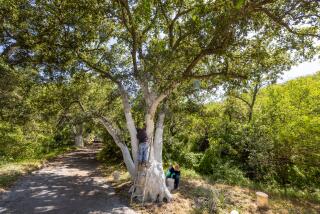Lawsuit filed to protect endangered southwestern willow flycatcher
- Share via
A U.S. Department of Agriculture program designed to control invasive streamside trees by releasing exotic leaf-eating beetles has gone awry and is destroying the nesting areas of a federally endangered songbird, according to a lawsuit filed Monday by two conservation groups.
The lawsuit filed in U.S. District Court in Las Vegas by the Center for Biological Diversity and the Maricopa Audubon Society accuses the department and its Animal and Plant Inspection Service, or APHIS, of failing to safeguard the southwestern willow flycatcher from the effects of the release of the beetles imported from central Asia to eradicate tamarisk trees.
Flycatchers often nest where tamarisks have crowded out native cottonwood and willow trees. About 25% of the birds’ territories are in areas dominated by the tamarisk, a water-hungry tree that grows in impenetrable thickets.
The department began releasing the beetles in 14 states in 2005 with assurances that the insects would not be introduced within 200 miles of flycatcher habitat. It also said the beetle could not survive in regions south of 37 degrees north latitude, where shorter days suppress its reproduction.
In an environmental assessment published two years earlier, APHIS officials said the strain of beetle “exhibits a particular life history that will enable its safe release in the 14 proposed states.”
According to the lawsuit, however, the department in 2006 introduced beetles into flycatcher-nesting areas along the Virgin River in southern Utah. Now, they are spreading into nesting areas in southern Utah, Nevada and northern and western Arizona.
“Their agreements were broken,” Robin Silver, a spokesman for the Center for Biological Diversity, said. “The beetle is going wild below 37 degrees north latitude.”
“If we don’t deal with this problem immediately, it will wipe out the middle part of the flycatcher’s range,” Silver said. “Eventually, there may not be enough habitat left to sustain the species.”
The lawsuit seeks mitigation, including that APHIS consult with the U.S. Fish and Wildlife Service to develop and fund a plan to replace tamarisks targeted by the program (which was terminated in 2010) with native willows and cottonwood trees.
“The APHIS program has been successful in terms of beetles killing tamarisks,” Mark Larson, president of the Maricopa Audubon Society, said in an interview. “But killing those tamarisks has left the flycatchers with no place to nest.”
An estimated 90% of the flycatcher’s historical breeding habitats have been wiped out or altered by river and stream impoundments, flood-control projects and groundwater pumping, federal wildlife authorities say. Other threats include the brown-headed cowbird, which takes over the nests of other birds, and ongoing destruction of tropical rainforests, where the flycatcher winters.
ALSO:
How much does a glass of wine contain? It may depend on the glass
Sayonara, silicon? Engineers build first carbon nanotube computer
Convicted earthquake scientist says he can’t be blamed for 309 deaths







